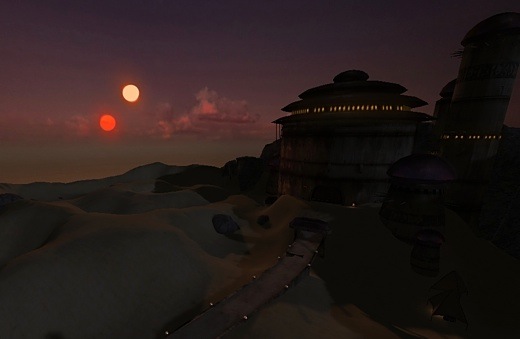SUBHEAD: We are discovering more double stars. Some have planetary systems as in Skywalker's home Tatooini.
By Jan TenBruggencate on 2 September 2012 for Raising Islands -
(http://raisingislands.blogspot.com/2012/09/tatooine-prime-is-not-alone-binary.html)

Image above: Jabba the Hut's palace on the desert planet Tatooini during a double star sunset. From (http://www.moddb.com/games/star-wars-jedi-academy/addons/jabbas-palace-tatooine-jedi-academy-mp).
.
By Jan TenBruggencate on 2 September 2012 for Raising Islands -
(http://raisingislands.blogspot.com/2012/09/tatooine-prime-is-not-alone-binary.html)

Image above: Jabba the Hut's palace on the desert planet Tatooini during a double star sunset. From (http://www.moddb.com/games/star-wars-jedi-academy/addons/jabbas-palace-tatooine-jedi-academy-mp).
The University of Hawaii managed to write about the discovery of planets around a binary star system without once mentioning the iconic planet, Tatooine.
Partly, that might be because there is far more about the new discovery than just the fact that a planet exists around two stars spinning in their own tight orbit. In this case, two planets (maybe three) around the two stars.
Tatooine, of course, is the desert planet in the Star Wars film series, which is the home planet to both Anakin and Luke Skywalker. In many of its scenes, Tatooine’s twin suns are displayed above the horizon.
University of Hawaii astronomer Nader Haghighipour was part of a team that discovered what they called Kepler-47, naming it after the Kepler space observatory, which was launched in 2009. The funding for the team’s work came from NASA and the National Science Foundation.
The team announced the finding at the triennial International Astronomical Union meeting in Beijing, and published it in Science—under the daunting title: “Kepler-47: A Transiting Circumbinary Multiplanet System.” The abstract is here.
What’s cool about this?
Binary star systems are cool, although this is not the first one that’s been found.
That this binary star system has a complement of planets is cool—first time that’s been seen. It proves that it’s possible for a solar system to exist around twin suns. The stars of Kepler-47 orbit each other roughly weekly—every 7.5 days.
And ultimate cool for science fiction fans and astronomers is one of the planets is within the stars’ habitable zone, meaning liquid water could exist on their surfaces. The question still unanswered is whether this planet even has a surface on which to have liquid water. It could be a gas giant like Jupiter—but maybe not.
The inner planet is smaller, three times Earth’s radius, and spins a full orbit around its suns in 49 days. The other—the one in the habitable zone—is Jupiter-sized at 4.6 times Earth’s radius and orbits every 303 days—not far from Earth’s 365.
And there may be a third planet, although the evidence isn’t yet strong enough to say for sure.
No comments :
Post a Comment